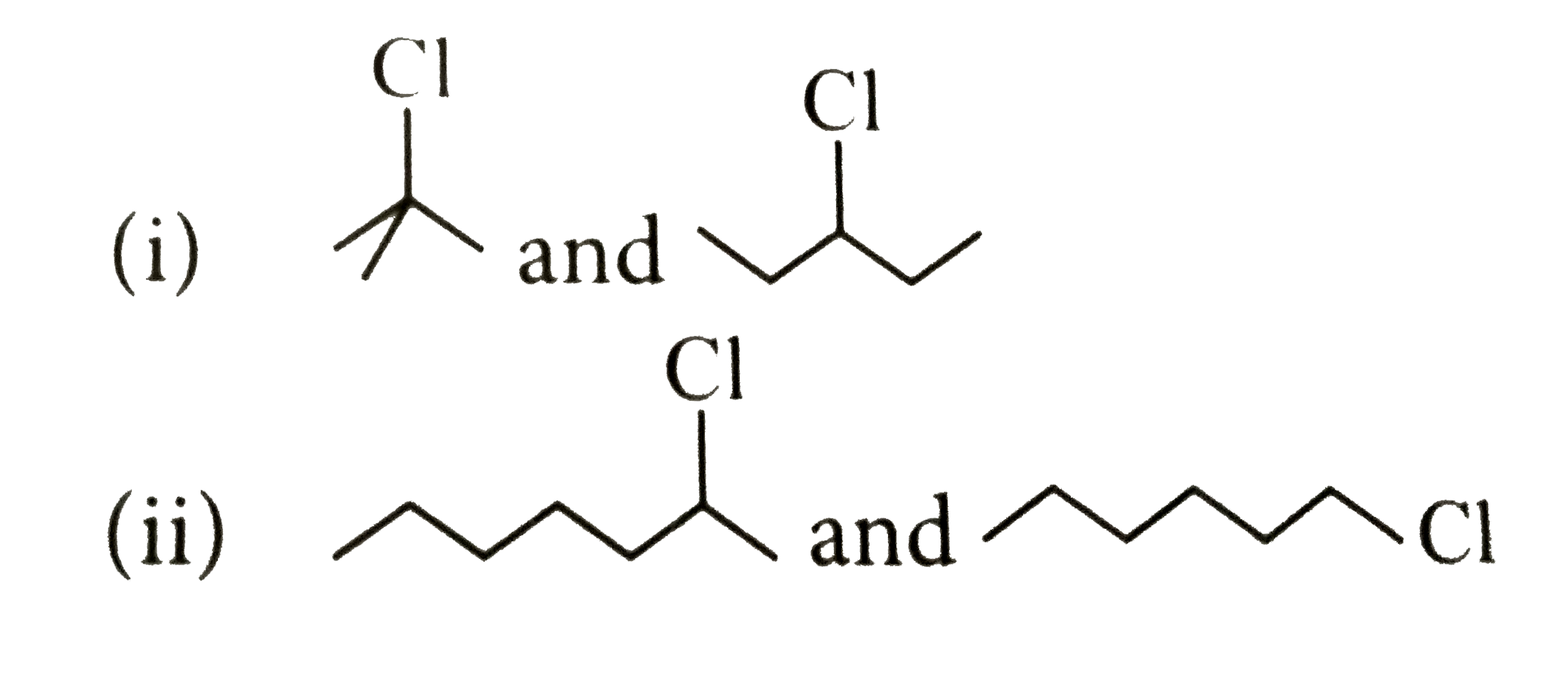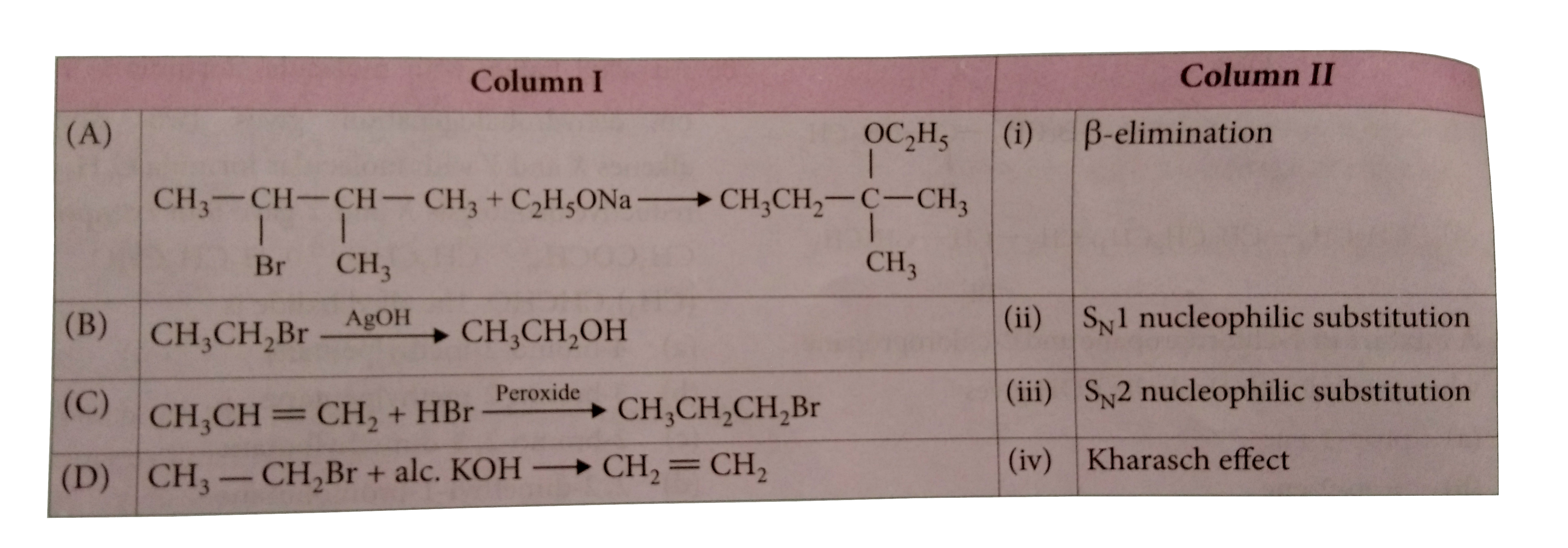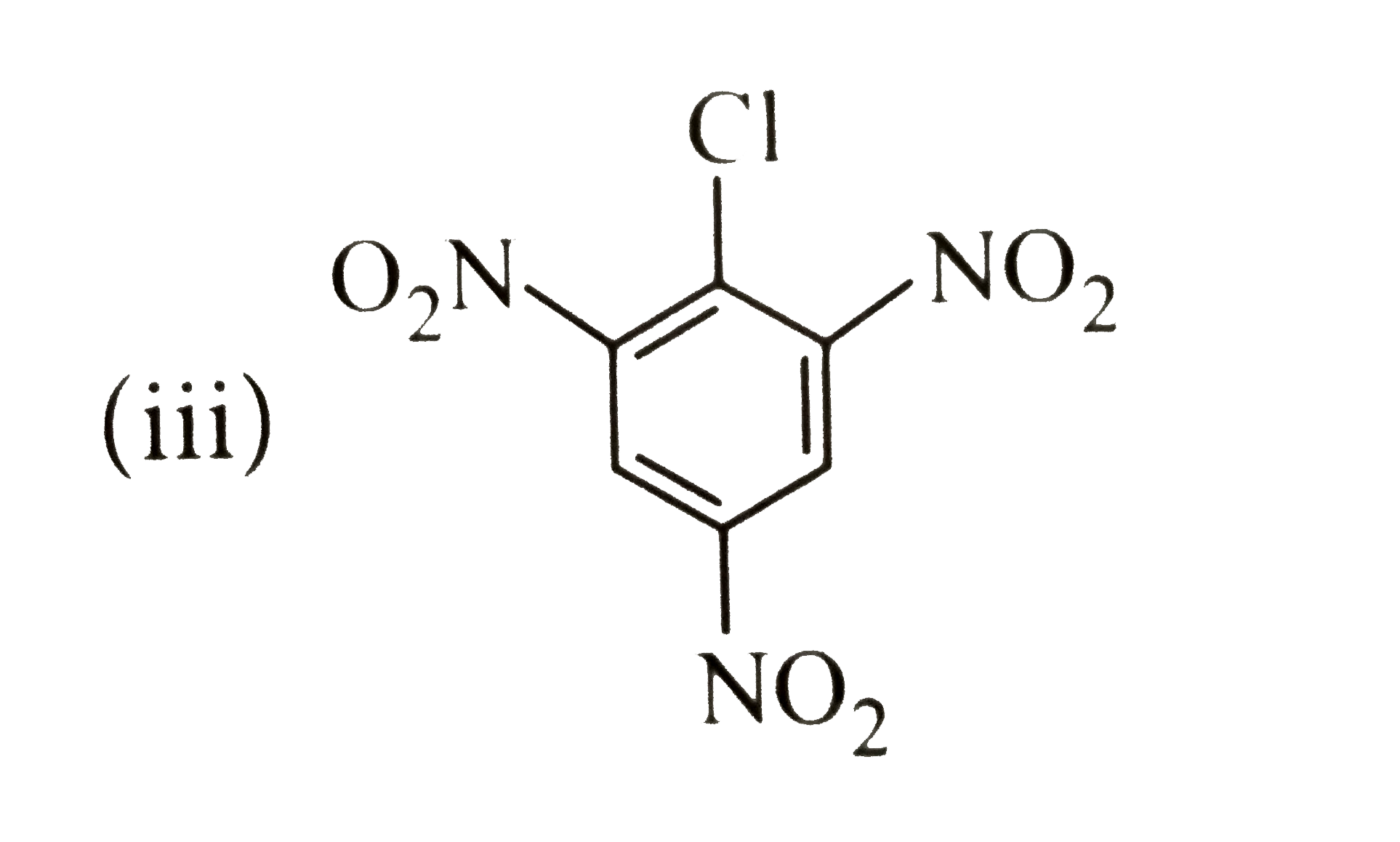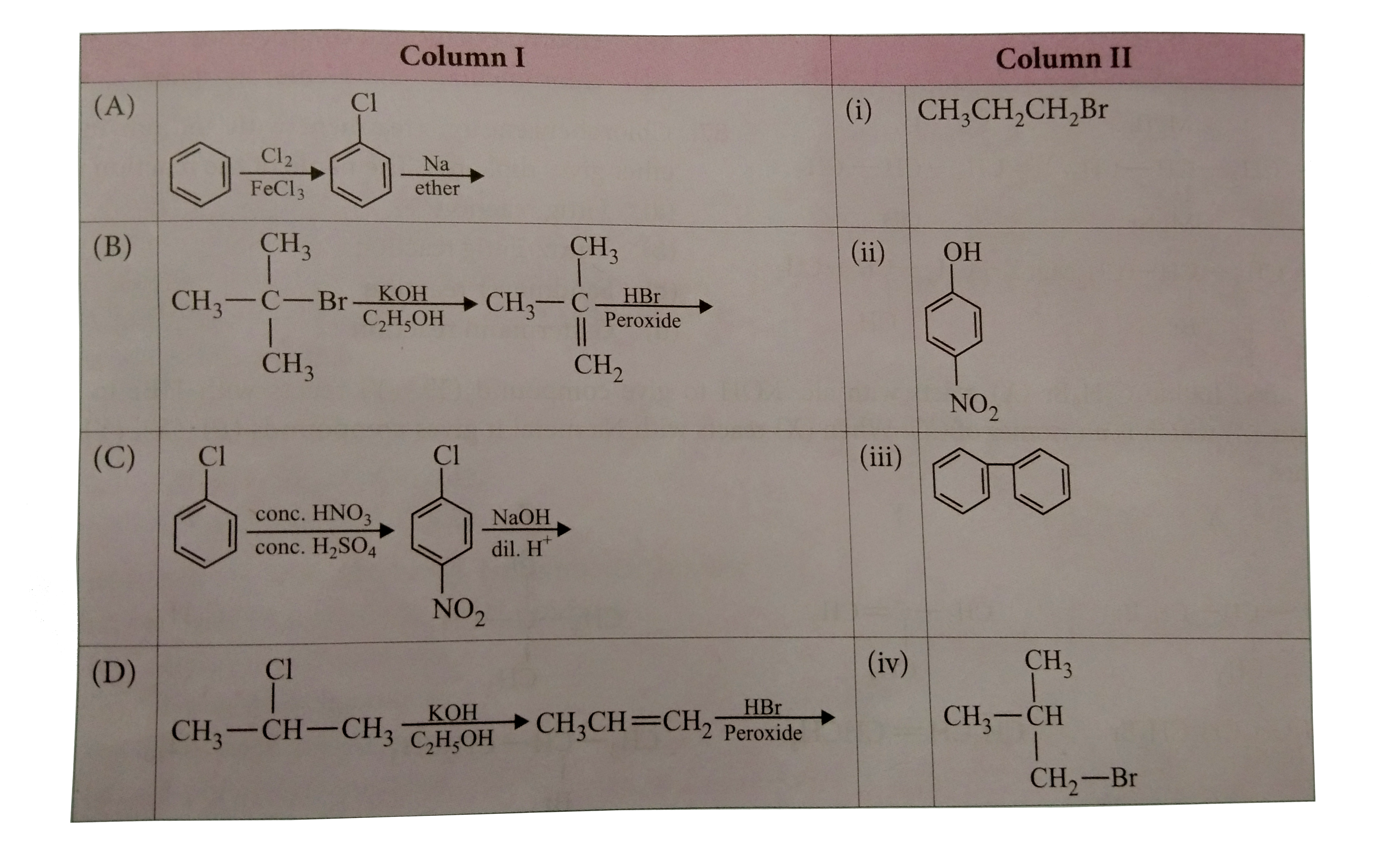Complete Solutions to Chemical reactions of chapter HALOALKANES AND HALOARENES of Class 12 book with complete answers and questions
| Class 12 | CHEMISTRY |
| Chapter | HALOALKANES AND HALOARENES |
| NCERT FINGERTIPS | Chemical reactions |
| Number Of Questions | 68 |
| Academic Year | 2023-24 |
Cyanide ion acts as an ambident nucleophille. From which end it acts as a strong nucleophile in aqueous medium? Give reason for your answer.
View SolutionIdentify the products (A) and (B) in the reactions.
`RX+AgCNtoul((A))+AgX`
`RX+KCNtoul((A))+KX`
View SolutionButanenitrile may be prepared by heating
View SolutionEthyl alcohol is obtained when ethyl chloride is boiled with :
View SolutionWhich of the following alkyl halides undergoes hydrolysis with aqueous `KOH` at the fastest rate ?
View SolutionIdentify the product of the following reaction.
`ClCH_2CH_2CH_2Br+KCNto`product
View SolutionThe alkyl halide is converted into an alcohol by
View SolutionAn alkyl halide, RX reacts with KCN to give propane nitrile. RX is
View SolutionIn `S_(N^2)` reactions the sequence of bond breaking and bond formation is as follows
View SolutionWhich of the following statement is not correct about `S_(N^2)` reactions of alkyl halides?
View SolutionIn the reaction given below:

Which of the following statements is corrects?
View SolutionTertiary alkyl halide are practially inert to substitution by `SN^(2)` mechanism because of-
View SolutionAmong the choices of alkyl bromide , the least reactive bromide in a `S_(N^(2))` reaction is :
View SolutionArrange the following compounds in order of their reactivity towards `S_(N^2)` reaction.
(i) `CH_3(CH_2)_3CH_2Br`
(ii) `(CH_3)_2CHCH_2CH_2Br`
(iii) `CH_3CH_2-overset(CH_3)overset(|)(CH)-CH_2Br`
(iv) `CH_3-underset(CH_3)underset(|)overset(CH_3)overset(|)C-CH_2Br`
View SolutionWhich of the following haloalkanes is most reactive?
View SolutionWhich of the following reactions does not take place?
View SolutionConsider the following bromides:

The correct order of `S_(N^1)` reactivity is
View SolutionWhich of the following statement regarding `S_(N)1` reaction shown by alkyl halide is incorrect?
View SolutionConsider the following reaction:
`C_6H_5-underset(H)underset(|)overset(CH_3)overset(|)C-Br+H_2Oto OH-underset(H)underset(|)overset(CH_3)overset(|)C-C_6H_5+HBr`
The reaction proceeds with 98% racemistation. The reaction may follow
View SolutionWhich one of the following chlorohydrocarbons readily undergoes solvolysis?
View SolutionWhich of the following is the most reactive towards nucleophilic substitution reaction?
View Solution`S_(N^1)` reaction is fastest in
View SolutionWhich of the following alkyl halides is hydrolysed by `S_(N^(1))` mechanism?
View SolutionWhich of the following will give enantiomeric pair on reaction with water due to presence of asymeteric carbon atom?
View SolutionWhich of the following is most reactive towards aqueous NaOH?
View SolutionIn the following pairs of halogen compounds, which compounds undergoes faster `S_(N^1)` reaction?

View SolutionWhich of the following haloalkanes reacts with aqueous KOH most easily ? Explain giving reason.
(i). 1-Bromobutane
(ii) 2-Bromobutane
(iii) 2-Bromo-2-methylpropane
(iv). 2-Chlorobutane.
View SolutionWhich alkyl halide exhibits complete racemisation in `S_(N^1)` reaction?
View SolutionThe order of reactivity of various alkyl halides towards nucleophilic substitution follows the order
View SolutionAlkyl halides are formed when thionyl chloride and _____ are refluxed in presence of pyridine. The order of reactivity `(3^(@)gt2^(@)gt1^(@))` is due to +1 effect of the alkyl group which____ the polarity of C-X bond.
View Solution2-Bromo-3,3- dimethylbutane on reaction with aqueous KOH yields X as the major product. X is
View SolutionAmong the isomers of `C_5H_11Cl`, the one which is chiral is
(i) 2,2-Dimethy-1-chloropropane
(ii) 2-Chloropentane
(iii) 2-Methyl-2-chlorobutane
(iv) 3-Chloropentane
View SolutionEthylene dichloride and ethylidene chloride are isomeric compounds. The false statement about these isomers is that they
View SolutionThe major product formed in the following reaction is
`CH_3-underset(H)underset(|)overset(CH_3)overset(|)C-CH_2Brunderset(CH_3OH)overset(CH_3O^(-))to`
View SolutionWhich of the following reactions will give the major and minor products?
`CH_3-CH_2underset(Br)underset(|)(CH)-CH_3underset("heat")overset(alc. KOH)toCH_3-underset((A))(CH=CH)+underset((B))(CH_3-CH_2-CH=CH_2)`
View SolutionThe products (A) and (B) are respectively.
(i) `CH_3-underset(Br)underset(|)(CH)-underset(CH_3)underset(|)(CH)-CH_3overset(C_2H_5ONa)to(A)`
(ii) `CH_2=overset(CH_3)overset(|)(C)-CH_2CH_3underset("Peroxide")overset(HBr)to(B)`
View SolutionA mixture of `1-`chloropropane and `2-`chloropropane when treated with alcoholic `KOH`, it gives
View SolutionConsider the following reaction and identify X and Y.
`{:(CH_3CH_2CH_2Ioverset(alc.KOH)rarrXoverset(HBr)rarrY),(" "X" "Y):}`
View SolutionAn alkyl halide with molecular formula `C_6H_(13)Br` on dehyrohalogenation gives two isomeric alkenes X and Y with molecular formula `C_6H_(12)`. On reductive ozonolysis X and Y gives four compounds `CH_3COCH_3`, `CH_3CH_2CHO` and `(CH_3)_2CHCHO`. The alkyl halide is
View SolutionArrange the following alkyl halides in order of dehydrohalgenation, `C_2H_5I` , C_2H_5Cl` , C_2H_5Br` , C_2H_5F`
View Solution2-Chloro-2-methylpropane on reaction with aqueous KOH gives X as the major product. X is
View SolutionWhich of the following products as shown by the dehydrohalogenation of alkyl halides with sodium ethoxide in ethanol is correctly marked as major product?

View SolutionMatch the reactions given in column I with the type of reaction mentioned in column II and mark the appropriate choice

View SolutionAn alkyl chloride produces a single alkene on reaction with sodium ethoxide and ethanol. The alkene further undergoes hydrogenation to yield 2-methylbutane. Identify the alkyl chloride from amongst the following :
View SolutionTrans-2-phenyl-1-bromocyclopentane on reaction with alcoholic KOH produces
View SolutionIdentify (Z) in the following reaction series,
`C_2H_5Ioverset("Alcoholic")underset("KOH")rarr(X)overset(Br_2)rarr (Y)overset(KCN)rarr (Z)`
View SolutionThe ease of dehydrohalogenation of alkyl halide with alcoholic KOH is-
View SolutionElimination of bromine from 2-bromobutane results in the formation of
(i)equimolar mixture of 1 and 2-butane
(ii)predominantly2-butene
(iii)predominantly 1-butene
(iv)predominantly 2-butyne.
View SolutionWhich of the following products does not match correctly with the reaction?
View SolutionIn the reaction ,
`CH_(3)-underset(Br)underset(|)(CH)-CH_(3)overset(alc.KOH)(to)(A)overset(HBr)underset("Peroxide")(to)(B) overset(NaI)underset("Acetone")(to)(C)`
The compound (C) is :
View SolutionGrignard reagent, a very useful starting compound for a number of organic reactions can be prepared by
View SolutionThe order of reactivities of methyl halide in the formation of Grignard reagent is
View SolutionIdentify the products X and Y in the given reaction,
`CH_3-underset(Br)underset(|)CH-CH_3+Mgoverset("Dry ether")rarrXoverset(D_2O)rarrY`
View SolutionAlkyl halides react with metallic sodium in dry ether producing
View SolutionOn treating a mixture of two alkyl halides with sodium metal in dry ether, `2`-methylpropane was obtained. The alkyl halides are
View SolutionChlorobenzene on treatment with sodium in dry ether gives diphenyl. The name of the reaction is
View SolutionPrimary alkyl halide `C_4H_9Br` (X) reacts with alc. KOH to give compound (Y). (Y) reacts with HBr to give compound (Z) which is an isomer of (X). When (X) reacts with Na metal it gives compound (P). (X), (Y), (Z) and (P) are
View SolutionThe main difference in C-X bond of a haloalkane and a haloarene is
View SolutionAryl halides are less reactive towards nucleophilic substitution reaction as compared to alkyl halides due to
View SolutionChlorobenzene can be converted into phenol by heating in aqueous sodium hydroxide solution at temperature of 623K and a pressure of 300atm. However the rate of reaction can be increased by presence of certain groups in benzene ring. What will be the order of reactivity of following compounds towards the above substitution reaction?


View SolutionMatch the column I with column II and mark the appropriate choice.

View SolutionThe end product (Q) in the following sequence of reaction is

View SolutionWhich of the following reactions is not correctly matched ?
View SolutionChloroform is stored in dark coloured bottles. Explain in not more than two sentences.
View SolutionTriiodomethane has antiseptic property because of
View SolutionThe fire extinguisher 'pyrene' contains
View SolutionAn organic halogen compound which is used as refrigerant in refrigerators and air conditioners is
View SolutionWhich one is correct?
View Solution
Chemical reactions questions and complete solutions for chapter HALOALKANES AND HALOARENES of MTG CHEMISTRY (ENGLISH) of Class 12